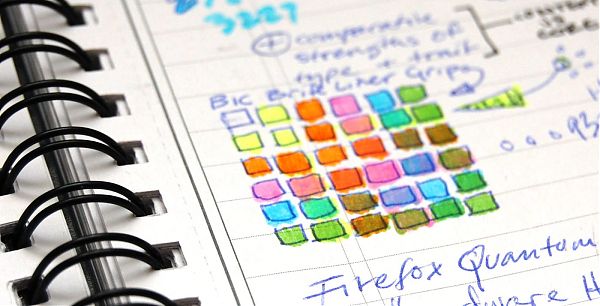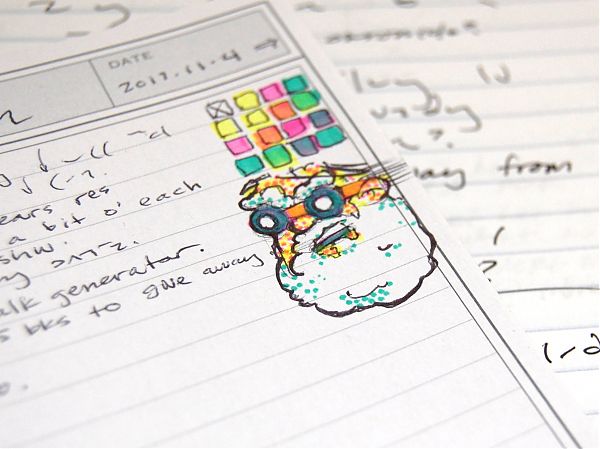Why I Like Using Highlighters
Monday February 19, 2018
Yesterday I was drawing a sketch of a (speculative) model for inflammation and depression, and I began to realize why I love using highlighters. As I fleshed out the reasoning, I thought I’d share it here:
- Highlighters allow us to color-code information.
- Color-coding is one way to easily classify information.
- Classification is an important activity because it divides information into types.
- Types are important because they generalize information and create an abstract view.
- Generalization and abstract views are important because they easily communicate the highest-impact information.
- High-impact information is important because it increases our ability to influence and solve problems.
- We must increase our ability influence and solve problems in order to feel like successful human beings.
- When we are at our most successful, we consider ourselves as uniquely-qualified problem-solvers.
I couldn’t stop thinking about this last night. I am always buying highlighters. I must have about ten different sets. My favorites are:
- Rite Aid “Wexford” highlighters. Low price, vibrant ink, good hues. Just a really good cost-to-performance ratio, especially if you buy them around mid-September when they’re on clearance for, say, $0.10 per pen. (Yes!!!)
- Zebra Kei Koat highlighters. Versatile double-tip, vibrant ink, small size.
- Sharpie Clear View highlighters. Vibrant ink, fat design that’s fun to hold.
- Bic Brite Liner Flex Tip highlighters. Brush tip (surprisingly versatile), relatively dull ink, but fun to use.
I like to have three to five highlighters nearby when I’m working or thinking. More than five is too many colors, and even three highlighters can be combined to make more than three colors. For example, yellow and blue make green, yellow and pink make orange, blue and pink make some kind of purple color.
When you want to go for more nuanced colors, you can use stippling. Tiny pink dots on top of yellow can make a passable skin color.
Going beyond aesthetic, beyond “I don’t know why, I just like highlighters,” there comes a time when a theorist must look at his ten sets of highlighters and think, “why?” The theorist naturally seeks leverage by deepening their search for knowledge about their own habits and those of others.
If you accumulate more than some average amount of a thing, chances are your subconscious is sending you a message about that thing. I’ve found that to be a very reliable assumption, as long as you leave the interpretation wide open. But it’s usually not just that you like that thing so why not buy ten of them. I have been why-ing about my highlighters for a while, and I discovered the schema above as I used them yesterday. It gave me a feeling of completion, with a satisfying little “click” sound in my brain as my mostly-unknown thought mechanisms slammed some coherent little bits of meaning together.
If you want an extra INTJ-related brain click, consider that modeling, classification, and systematization are associated with introverted and extraverted thinking (Ti and Te). Highlighters can help with all of that good stuff.
I believe there is a Highlighter Martial Art lurking in here somewhere. “Highlighters classify information” can give us a bit of insight into graphic design theory, perhaps. Highlighters do more than just randomly highlight sentences that might be on a test. It’s now obvious to me in a way that might open a path to doing even cooler things with highlighters and information. You never know.
Filed in: Te /36/ | Ti /30/ | Productivity /120/ | Thinking /70/ | Aesthetics /4/
Recent Articles
Just Writing to Write, Just Expressing Because it's Life →
The NT Factor: How Harris and Walz's Personality Types Could Shape Their Presidential Bid and/or Presidency →
Predictive Contenders: Allan Lichtman (ENTP) and Cenk Uygur (INTJ) on US Presidential Election Predictions →
How to Organize & Structure a New Binder or Notebook (Fractal Method) →
Sharpening, Reading, Listening, Watching, Timing. →
Things I Made for You
Own your procrastination with Whole Productivity, a new system → Get my free INTJ COVID-19 Guide → Explore your gifts with my INTJ Workbook → Other Publications → ...and the fake word of the hour: "Serrkinent." I think this is related to disgusting smells.


